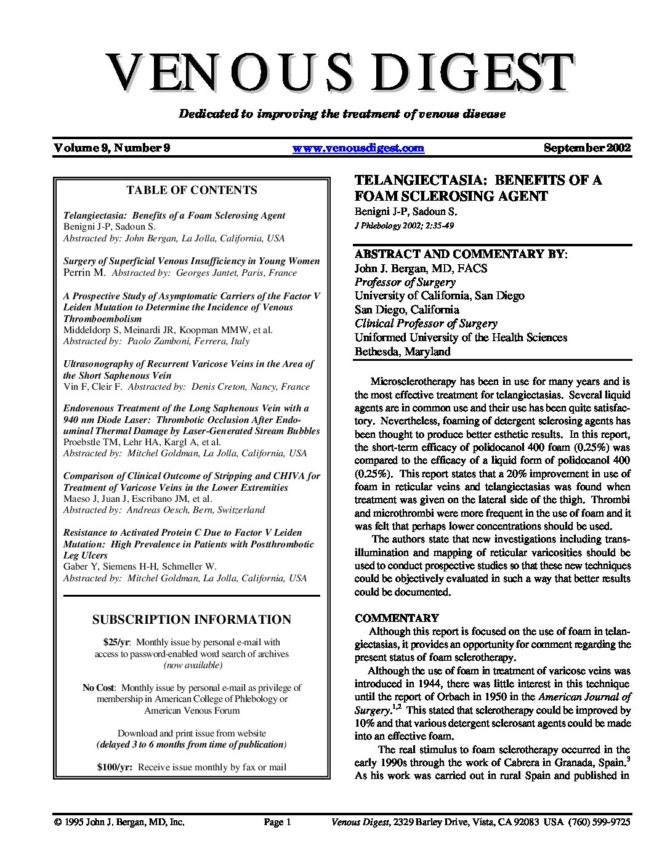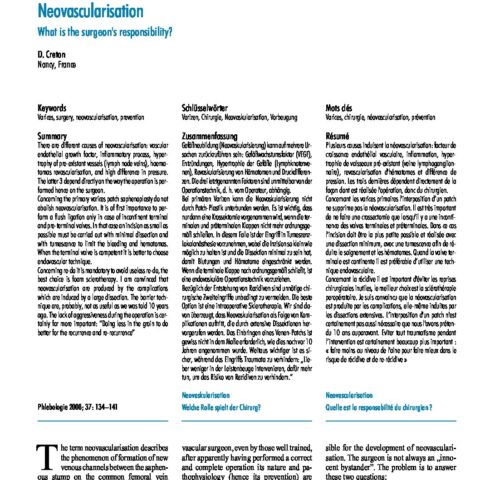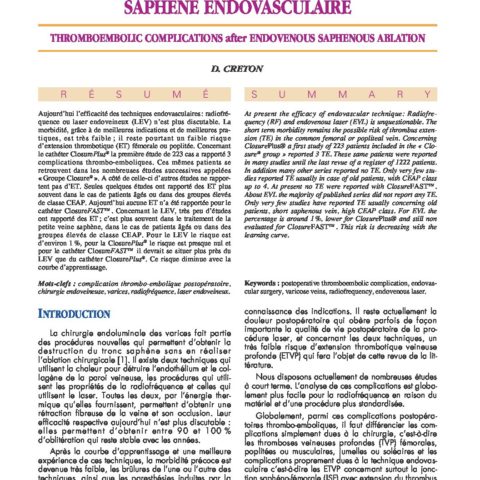Ultrasonography of recurrent varicose veins in the area or the short saphenous vein

Ultrasonography of recurrent varicose veins in the area or the short saphenous vein
The aim of this study was to classify recurrent varicose veins in popliteal fossa. A retrospective ultrasound Doppler exploration was carried out in 60 patients (77 limbs) recruited as they were consulting for a systematic checkup for clinical signs of venous insufficiency or presence of varicose veins on the posterior aspect of the calf. The average interval after surgery of the short saphenous vein (SSV) was 9.2 years. Five types of anatomical recurrences were defined: Long residual stump (part of the saphenopopliteal junction) 14.8%, intact SSV in its usual anatomical position 32.2%, perforators in the popliteal fossa 21% (one-third was a popliteal fossa vein and two-thirds were gastrocnemius perforators), complex varicose network around the deep veins (neovascularization) 3.7%, and varicose veins in the calf fed by the long saphenous vein 28.4%. The authors concluded that 47% of these patients had an insufficient excision of the short saphenous vein. They emphasized the lack of preoperative ultrasound scanning and mapping observed in this group.
COMMENTARY
Recurrence of popliteal fossa varicose veins has long been attributed to insufficient excision of an incompetent SSV. The authors reviewed ultrasound data of a group of patients previously operated on for incompetent SSV. The lack of precision concerning the method of recruitment can be criticized along with the scarcity of details about the primary preoperative observation. These factors may explain the high rate of intact SSV. However, the merit of this study has been to demonstrate the essential role of preoperative ultrasound Doppler scanning in decreasing the risk of insufficient excision.
A similar group of 125 patients showing recurrent popliteal varicose veins after excision of the SSV has been observed.1 However, in this case, the study was carried out according to the anatomic presentation at reoperation. Those patients were selected for surgery because investigation demonstrated that the point of emptying of the incompetent vein into the deep vein was located in the popliteal fossa. Recurrences were classified into 5 types: 1) An intact SSV with an incompetent saphenopopliteal junction 13.6%; 2) a long residual stump due to a ligation of the saphenopopliteal junction too far away from the popliteal vein 42.4%; 3) a residual incompetent saphenous trunk associated with a long residual stump 19.2%; 4) perforators in the popliteal fossa in their usual anatomical pattern and location 23.2%; and 5) popliteal varicose veins connected by neovascularization with vasa nervorum of the sciatic nerve.
The difference in frequency between ultrasound and surgical classifications allows us to emphasize the difficulty of ultrasound scanning in varicose vein recurrences in thepopliteal fossa. This anatomical study of repeat surgery shows that roughly 75% of cases were due to insufficient excision of the SSV, more often upwards (saphenopopliteal junction) than downwards (saphenous trunk) and roughly 23% were unpredictable recurrences in the form of a perforator of the popliteal fossa.
Actually, some investigators2,3 have indirectly studied the course of the residual long incompetent SSV (ligation made at a distance from the popliteal vein). These investigators reported a recurrence rate of between 13.5% and 31%. Development of such recurrences can be explained by the very high rate of collateral veins at the saphenopopliteal junction. In the general course of the recurrence, the pathological role of the long residual stump is easy to explain in much the same way as development of a perforator of the popliteal fossa is difficult to explain.
Recurrence represented by a perforator in the popliteal fossa seems to have a specific etiology. Indeed, there is nothing to explain why this type of recurrent popliteal varicose vein is significantly more common in men than in women (p<0.05) (specific mechanisms of increased venous pressure ?). The popliteal venous confluence is a system of junctions between many muscular collecting veins in the leg and the collecting venous trunks in the thigh. In addition, this area is subject to major movements of flexion/extension and sudden changes in pressure in the popliteal vein during contraction of the gastrocnemius veins. The saphenopopliteal junction, just as perforators of the popliteal fossa, is located just proximal to the inferior popliteal valve, the most effective valve.4 Consequently, they are especially vulnerable to sudden, dynamic, intrapopliteal venous hypertensive variations. In the future, the physiology of the popliteal venous confluence will be in order to explain the great clinical difference between the SSV recurrences and GSV recurrences.
REFERENCES
- Creton D. 125 réinterventions pour récidives variqueuses poplitées après exérèse de la petite saphène. (Hypothèse anatomique et physiologique du mécanisme de la récidive). J Mal Vasc 1999; 24:30-36.
- Fischer R. Der gegenwärtige Stand der Parvachirurgie. Vasomed 1995; 7::312-318.
- Mildner A, Hilbe G. Parvarezidive nach subfaszialer ligatur. Phlebologie 1997; 26:35-39.
- Van Der Stricht J, Staelens I. Veines musculaires du mollet. Phlébologie 1994 ; 47:135-143.
| Date | 2001 |
| Auteurs | Ann Chir 2001; 126:320-4 Vin F, Cleir F. ABSTRACT AND COMMENTARY BY:Denis Creton, MD, EC-AP, Nancy, France |






